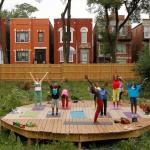PTSD in Poor Neighborhoods Could Be Worse than We Think

Inger Burnett-Zeigler, a psychologist and professor at Northwestern’s medical school, went to a community-based health clinic on the South Side as part of a study to bring mental-health treatments grounded in mindfulness to the patients there: simple meditation and yoga, body visualizations, and talking about stress and how it manifests in the body.
“It’s really getting people to understand the connection between mind and body, empowering people with the tools that they need in order to, as I describe, respond versus react to stressful situations,” Burnett-Zeigler says. It’s something a lot of people are trying right now in communities with lots of stressors: the well-regarded Becoming a Man program uses breathing and meditation exercises; the University of Chicago’s Crime Lab just began a study of David Lynch’s school-based transcendental meditation program in Chicago and New York. Cops are trying it too.
Burnett-Zeigler was working in Oakland, which borders Bronzeville and Kenwood, where the average income is around $26,000 (about $20,000 lower than the city-wide average) and the population is heavily dependent on Medicaid. The unemployment rate is almost 27 percent, compared to 11 percent citywide. Like a lot of poor neighborhoods, it has problems with violence, but it’s not at the extremes—it ranks seventh in property crime, 26th in quality of life crime, and 35th in violent crime, out of 77 community areas. It’s a place where you might expect mental-health needs to be considerable.
Even in that context, though, something emerged that surprised Burnett-Zeigler, enough that she wrote a report on it, with co-author Sunghyun Hong, that appears in The Journal of Racial and Ethnic Health Disparities.
“As a part of the assessment for women in that study, we noticed that women were reporting both trauma experiences and meeting criteria for PTSD diagnosis at rates much higher than what we expected,” Burnett-Zeigler says. “In the general population, about 20 percent of individuals who have had a traumatic experience will meet criteria for PTSD. There’s some limited literature to suggest that individuals in low-income, high-violence-rates might have a higher rate, but that’s really an area that has not been explored much to date. This was kind of pointing to substantially increased prevalence in a disadvantaged neighborhood.”
Half the women in her sample self-reported a trauma by the strict definitions of the research—"exposure to an actual or threatened death, serious injury, or sexual assault,” according to Burnett-Zeigler. Of those women, 57 percent were diagnosed with post-traumatic stress disorder, and another 13 percent had “subthreshold PTSD,” meaning they had some of the symptoms but not enough for a diagnosis.
It’s a high percentage of the sample having suffered from the kind of trauma that can cause PTSD. Of the 24 women who were able to detail their trauma, nine reported ones that had to do with murder or death—a son who was shot ten times, a father killed at home. Twelve reported physical or sexual abuse.
But it’s a much higher percentage of those who’ve suffered trauma also suffering from PTSD.
“It’s a testament to the high levels of mental health need, as far as depression and PTSD; we also saw a lot of anxiety come up, which can be a symptom of PTSD, and is often with depression as well,” Burnett-Zeigler says.
It’s a small sample, admittedly; Burnett-Zeigler hadn’t set out specifically to study PTSD. But it’s something of a warning to be, well, mindful—first of a high potential for trauma in communities like the one she was working in, but also of the idea that such trauma could be more likely to turn into PTSD as well.
“There’s been a lot of attention given to violence in the city of Chicago, and less discussion of how the violence is impacting these communities as a whole, and the mental health of these communities,” Burnett-Zeigler says. “So bringing an increased awareness to that issue is really key.”
